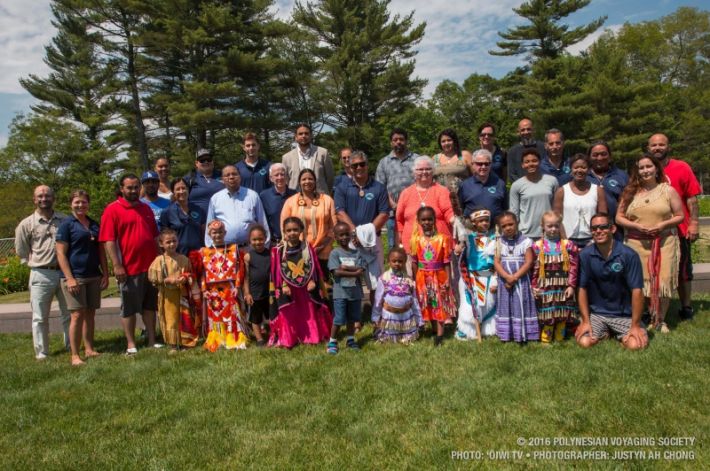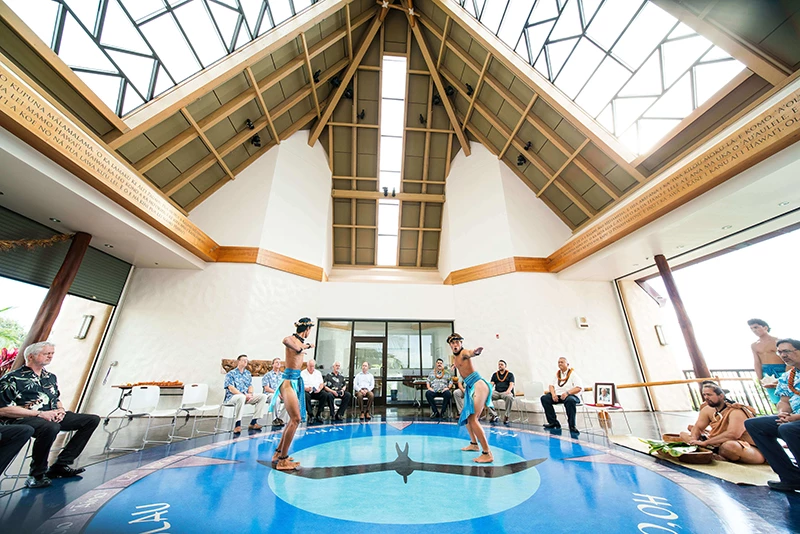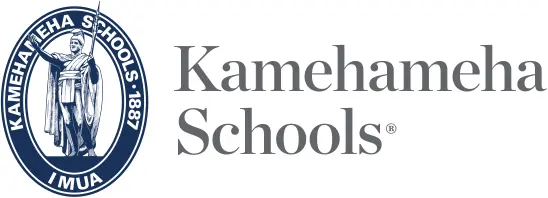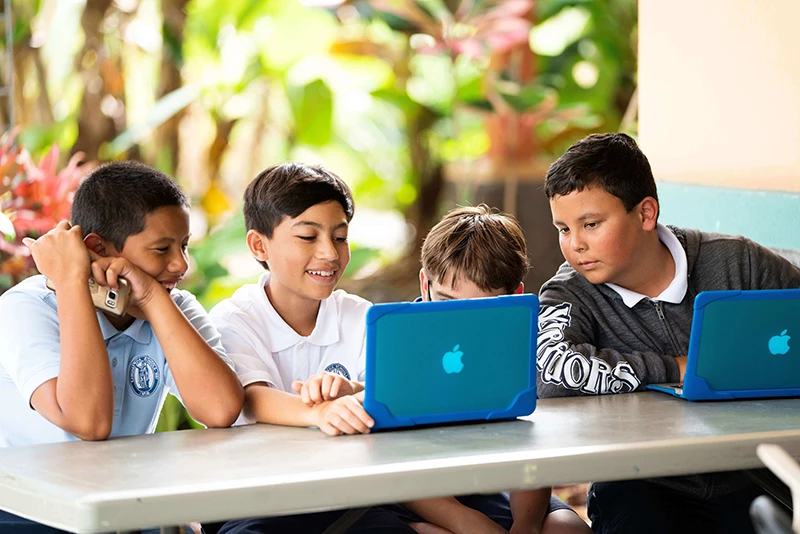After departing Block Island in Rhode Island on June 23, the Hōkūleʻa crew made its way to a new state as it arrived in Connecticut’s Mystic Seaport. There crews engaged in a historic interaction with the Manshantucket Pequot tribal nation. The waʻa was escorted up the Mystic River by paddlers in a mishoon, a traditional dugout canoe, built by the Mashantucket Pequot people.
Representatives of the Mashantucket Pequot tribal nation, a community with deep ancestral ties to the whaling world, honored Hōkūleʻa's arrival through welcome speeches, ceremonial chants, a friendship dance, and symbolic gifts of blankets and herbs. Mystic Seaport Museum hosts also presented the crew with a house flag of the Charles W. Morgan, a historic American whaling ship.
"Pequot means people of the shallow water; we are coastal people. We rely on water for survival," a Mashantucket Pequot representative shared with the Hōkūleʻa crew during the welcome ceremony.
"We feel at home in the water, and it's an honor to have you here to come share your culture with us, and for us to share ours with you."
After the welcome ceremony, crewmembers were invited by tribal council members and elders to visit the world-renowned Mashantucket Pequot Museum, a facility that features Pequot history and culture through life-sized walk-through exhibits. While in Mystic, the Hōkūleʻa crew participated in the 25th Annual Wooden Boat Show, a local event attended by around 10,000 people.
At the show, Hōkūleʻa was available for canoe tours, and the crew answered questions and discussed the Mālama Honua Worldwide Voyage.
The crew held two technical talks on Saturday. Navigator Kaleo Wong lectured on the science and art of traditional Pacific Canoe Navigation. Captain Bruce Blankenfeld and crewmember Moani Hemuli presented a demonstration on canoe lashing, sharing techniques learned from legendary master navigator Mau Piailug. Catherine "Cat" Fuller and other Hōkūleʻa crewmembers teamed up with the Mystic Seaport Museum's Planetarium staff and offered two presentations of a special show, "Traditional Polynesian Navigation" on Friday and Sunday. All events that involved Hōkūleʻa and her crew were well-attended by the boat show crowd.
"Hōkūleʻa is perhaps the most important boat that's here this weekend," said Susan Funk, executive vice president and COO of Mystic Seaport Museum, said at the event.
"It's a boat that has an important story to tell, it's a program that has a lot of the same goals, mission and educational features that are important to our museum - awareness of the environment, understanding of science and technology and the connection between traditional methods and contemporary methods."
From Mystic Seaport, the Hōkūleʻa made its way to Martha’s Vineyard, Massachusetts, an area accessible only by boat or air travel.
For Hōkūleʻa's sail to the dock, she was escorted by the Wampanoag - a Native American tribe on the US east coast – in a mishoon they had just finished building. The mishoon was the first one built on the island in over 300 years. Captain Bruce Blankenfeld displayed two strands of wampum (beads made from shell) that the crew received from the tribe, to acknowledge the Wampanoag nation's welcome.
The canoe's arrival was particularly meaningful to Sanford Low, a Hōkūleʻa crewmember and current resident of Martha's Vineyard.
"To me, this day could not have gone better; it was full of aloha, it was full of spirit, and it was just plain joy," Low said.
"This is really a joining of two different islands across a massive ocean... This canoe has come, these people, this crew has come to learn from the people of Martha's Vineyard and take back to Hawaiʻi."
On Friday, July 1, the canoe was in Woods Hole, Massachusetts, where it spent the fourth of July weekend with the Native American communities in that area. A few members of the Aquinnah Wampanoag tribe and local community organizers that the crew connected with at Martha's Vineyard accompanied the Hōkūleʻa crewmembers on their latest sail.
The canoe's noon arrival at Woods Hole was marked by a greeting at Dyer's Dock from representatives of the Mashpee Wampanoag tribal nation and the Woods Hole Oceanographic Institute community. A short welcome ceremony was performed, including the performance of a song written about Hōkūleʻa by the children of the Neekun School, a Wôpanâak Language immersion program.
"In this day and age, we know that it can be confusing about what is meaningful. But this is. This gathering, this togetherness is historical and we will speak of it for generations to come," said Ramona Peters, an elder of the Mashpee Wampanoag, during the arrival ceremony.
The Mashpee Wampanoag Tribe, known as the People of the First Light, has inhabited present-day Massachusetts for more than 12,000 years.
After Woods Hole, the canoe made way for New Bedford on its way to Boston, Massachusetts. To follow the Mālama Honua Worldwide Voyage and see where in the world is Hōkūleʻa, visit http://hokulea.com/track-the-voyage.
Kamehameha Schools is proud to be the Education Sponsor of the Hōkūleʻa Worldwide Voyage. For more information about the Polynesian Voyaging Society and the Worldwide Voyage, visit hokulea.com or find the society on Facebook, Twitter, Instagram, YouTube and Google+.

The Mashantucket Pequot tribal representatives take time for a photo on the grounds of the Mashantucket Pequot Museum.

Hōkūleʻa captain Bruce Blankenfeld at the arrival ceremony in Mystic Seaport, Connecticut.

Hōkūleʻa sails into Woods Hole, MA.
TAGS
malama honua voyage
CATEGORIES
Kaipuolono Article, Newsroom, Department News, Ho‘okahua, Mālama Honua
Print with photos
Print text only










